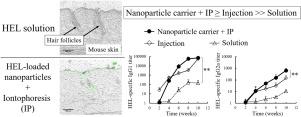当前位置:
X-MOL 学术
›
Colloids Surf. A Physicochem. Eng. Aspects
›
论文详情
Our official English website, www.x-mol.net, welcomes your
feedback! (Note: you will need to create a separate account there.)
Iontophoretic transdermal delivery using chitosan-coated PLGA nanoparticles for transcutaneous immunization
Colloids and Surfaces A: Physicochemical and Engineering Aspects ( IF 4.9 ) Pub Date : 2021-01-01 , DOI: 10.1016/j.colsurfa.2020.125607 Issei Takeuchi , Takaaki Suzuki , Kimiko Makino
Colloids and Surfaces A: Physicochemical and Engineering Aspects ( IF 4.9 ) Pub Date : 2021-01-01 , DOI: 10.1016/j.colsurfa.2020.125607 Issei Takeuchi , Takaaki Suzuki , Kimiko Makino

|
Abstract Transdermal administration of poly( dl -lactide-co-glycolide) (PLGA) nanoparticles using iontophoresis (IP) is useful for efficient drug delivery to hair follicles. In this study, we investigated the possibility of using it in allergen immunotherapy. Hen egg-white lysozyme (HEL) was used as a model antigen. We successfully prepared PLGA nanoparticles with a mean volume diameter of 98.4 ± 36.8 nm using an antisolvent diffusion method. The PLGA nanoparticles were coated with chitosan hydroxypropyltrimonium chloride to shield the PLGA-derived negative charge. The surface charge number density was calculated to be 1.28 × 10−2 M, confirming that the particles had positive charges. An uptake test into dendritic cells was performed using fluorescently labeled HEL. The results of FACS measurement showed that the usage of the nanoparticle carrier increased the mean fluorescence intensity by 5.6 times. An ex vivo skin accumulation study was carried out using abdominal mouse skin and a Franz-type diffusion cell with and without IP. When IP was applied to the nanoparticles, the HEL concentration in mouse skin was 9.6 times higher than that without IP and 2.1 times higher than that of the HEL solution. Images of skin sections confirmed that HEL was efficiently delivered to hair follicles using IP and nanoparticle carriers. HEL-specific IgG1 and IgG2a titers were determined in an in vivo percutaneous immunoreactivity study. Ten weeks after the initiation of the test using IP and the nanoparticle carrier, HEL-specific IgG1 and IgG2a titers were 7.4 × 104 and 6.6 × 102, respectively. Both values were higher than those obtained by subcutaneous injection of HEL solution, indicating the effectiveness of the combined use of IP and nanoparticle carriers.
中文翻译:

使用壳聚糖包覆的 PLGA 纳米粒子进行经皮免疫的离子电渗透皮递送
摘要 使用离子电渗疗法 (IP) 对聚 (dl-丙交酯-共-乙交酯) (PLGA) 纳米颗粒进行透皮给药有助于将药物有效递送至毛囊。在这项研究中,我们调查了在过敏原免疫治疗中使用它的可能性。鸡蛋清溶菌酶(HEL)用作模型抗原。我们使用反溶剂扩散方法成功制备了平均体积直径为 98.4 ± 36.8 nm 的 PLGA 纳米粒子。PLGA 纳米粒子涂有壳聚糖羟丙基三甲基氯化铵以屏蔽 PLGA 衍生的负电荷。计算出的表面电荷数密度为 1.28 × 10-2 M,证实颗粒具有正电荷。使用荧光标记的 HEL 对树突细胞进行摄取测试。FACS 测量结果表明,使用纳米颗粒载体使平均荧光强度提高了 5.6 倍。使用腹部小鼠皮肤和带有和不带有 IP 的 Franz 型扩散池进行了离体皮肤积累研究。当 IP 应用于纳米粒子时,小鼠皮肤中的 HEL 浓度比没有 IP 时高 9.6 倍,比 HEL 溶液高 2.1 倍。皮肤切片图像证实,使用 IP 和纳米颗粒载体可以有效地将 HEL 输送到毛囊。在体内经皮免疫反应性研究中确定了 HEL 特异性 IgG1 和 IgG2a 滴度。使用 IP 和纳米颗粒载体开始测试十周后,HEL 特异性 IgG1 和 IgG2a 滴度分别为 7.4 × 104 和 6.6 × 102。
更新日期:2021-01-01
中文翻译:

使用壳聚糖包覆的 PLGA 纳米粒子进行经皮免疫的离子电渗透皮递送
摘要 使用离子电渗疗法 (IP) 对聚 (dl-丙交酯-共-乙交酯) (PLGA) 纳米颗粒进行透皮给药有助于将药物有效递送至毛囊。在这项研究中,我们调查了在过敏原免疫治疗中使用它的可能性。鸡蛋清溶菌酶(HEL)用作模型抗原。我们使用反溶剂扩散方法成功制备了平均体积直径为 98.4 ± 36.8 nm 的 PLGA 纳米粒子。PLGA 纳米粒子涂有壳聚糖羟丙基三甲基氯化铵以屏蔽 PLGA 衍生的负电荷。计算出的表面电荷数密度为 1.28 × 10-2 M,证实颗粒具有正电荷。使用荧光标记的 HEL 对树突细胞进行摄取测试。FACS 测量结果表明,使用纳米颗粒载体使平均荧光强度提高了 5.6 倍。使用腹部小鼠皮肤和带有和不带有 IP 的 Franz 型扩散池进行了离体皮肤积累研究。当 IP 应用于纳米粒子时,小鼠皮肤中的 HEL 浓度比没有 IP 时高 9.6 倍,比 HEL 溶液高 2.1 倍。皮肤切片图像证实,使用 IP 和纳米颗粒载体可以有效地将 HEL 输送到毛囊。在体内经皮免疫反应性研究中确定了 HEL 特异性 IgG1 和 IgG2a 滴度。使用 IP 和纳米颗粒载体开始测试十周后,HEL 特异性 IgG1 和 IgG2a 滴度分别为 7.4 × 104 和 6.6 × 102。











































 京公网安备 11010802027423号
京公网安备 11010802027423号